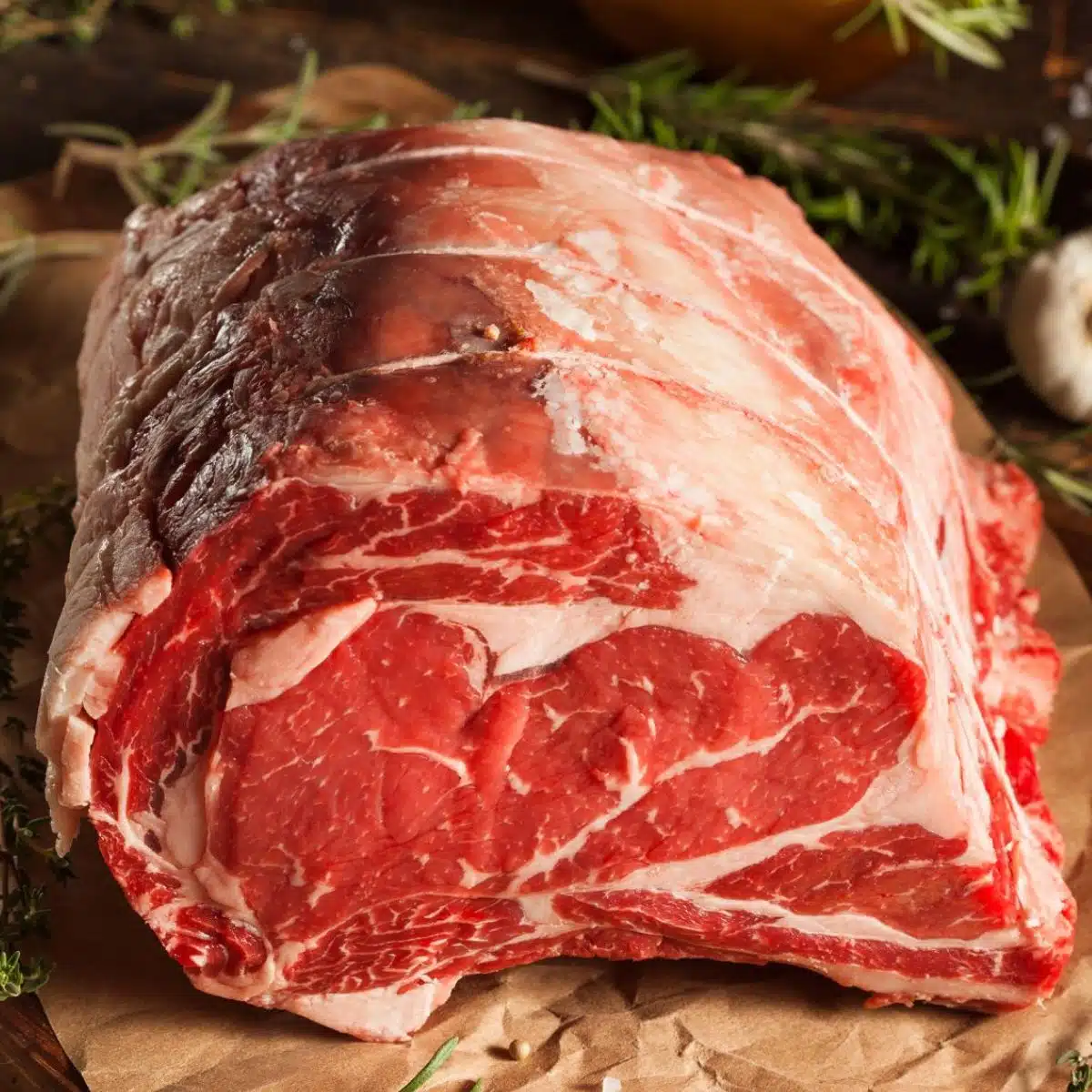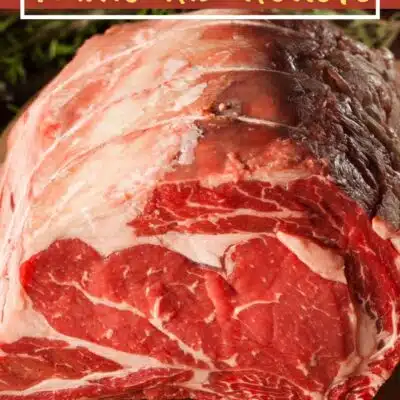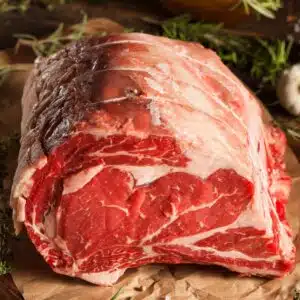Here's how to safely thaw prime rib roast so you can make delicious and flavorful meals whenever you like! Whether you are cooking for the holidays, a family get-together, or just because, you'll need to know how to defrost your frozen prime rib (and how long it will take). This guide is going to walk you through all of the best methods for thawing your roast.
Safest Ways To Thaw Prime Rib Roasts
There are a ton of different reasons why you might have some prime rib in the freezer. No matter the reason, you'll need to defrost it before whipping up your favorite prime rib recipes!
I'm going to walk you through all the different methods you can use to thaw your prime rib safely. Before getting started, make sure you know how to select the best prime rib roast!

Jump to:
It is crucial that you defrost your meat in a safe manner. If you fail to do so, the meat could grow bacteria and lead to food-borne illnesses!
For more information on storing prime ribs, check out my post about how long prime ribs can be kept in the freezer!
Thaw In The Fridge (Recommended)
Thawing your roast in the refrigerator is the best method, but also takes the longest amount of time. Therefore, you need to make sure you plan accordingly!
It could take anywhere from overnight to three days, depending on the size and weight of your roast.
This method is the safest due to the temperature of the refrigerator. It is cold enough (and remains the same temperature) in order to prevent bacteria from growing.
How To Thaw Prime Rib In The Refrigerator
Thawing prime rib in the refrigerator is an easy, hands-off process! Simply transfer your roast from the freezer to the fridge and set it in a large bowl or rimmed baking sheet on the lowest shelf of the fridge to prevent cross-contamination.
Thaw In Cold Water
This is another great option for thawing your prime rib! It is quicker than using the refrigerator but does require much more effort.
Specifically, you'll have to constantly change out the water to keep it from warming up too much (which can promote bacteria growth).
How To Thaw Prime Rib In Cold Water
First, make sure your sink is clean. Then, fill it with cold water. Completely submerge your prime rib (still wrapped, in a bag, or in the package), making sure that it is completely covered with water.
You will need to change the water every 30 minutes to ensure it stays cold.
Thaw In The Microwave
The microwave is definitely the fastest option for thawing your meat, but it is not as efficient. Be warned that using the microwave may alter the texture of your prime rib.
How To Thaw Prime Rib In The Microwave
Make sure to use the defrost function of your microwave and set it according to the weight of your prime rib. It is also important to flip the meat halfway through the defrost time.
How Long Does It Take To Thaw Prime Rib
The amount of time it takes to thaw your prime rib roast depends on a few different factors. First of all, whether or not your meat is boneless or bone-in. Secondly, the method you choose to defrost the prime rib. Finally, the weight of the roast.
Using the refrigerator will defrost a frozen prime rib at a rate of about 4-7 hours per pound. An average prime rib roast of 5 pounds will take anywhere from 20 - 35 hours to defrost.
If you defrost your roast in cold water, your thawing time will be reduced to about 30 minutes per pound.
How To Cook Frozen Prime Rib
Sometimes things happen and we completely forget to defrost our prime rib in time to cook it. Don't worry! You can absolutely cook your prime rib roast straight from frozen.
Of course, this option is best suited to smaller portions of prime rib but will work for even an entire roast.
The trade-off for this convenience is that it will increase your cooking time by about 50%, so it is definitely not a quick trick. Cook the prime rib based on your chosen recipe, but adjust the cooking time as needed.
Now you know how to safely thaw prime rib roasts. Leave a comment down below and let me know what your favorite prime rib recipes are!
🥩 Prime Rib Recipes
- Smoked Bison Prime Rib - If you are in the mood for something different, try out smoking a delicious bison prime rib!
- Smoked Prime Rib - Fire up your smoker for this effortless, hands-off prime rib roast recipe!
- Oven Roasted Prime Rib - This classic recipe will show you exactly how to roast your prime rib in the oven.
- Prime Rib Fried Rice - Use your delicious prime rib to make some amazingly tasty fried rice!
- Prime Rib Ragu - If you are a pasta lover, this prime rib ragu recipe is a must-try!
- Prime Rib Chili - For an elevated chili dish, use prime rib instead of your standard ground beef!
Do you love a recipe you tried? Please leave a 5-star 🌟rating in the recipe card below and/or a review in the comments section further down the page.
Stay in touch with me through social media @ Pinterest, Facebook, Instagram, or Twitter! Subscribe to the newsletter today (no spam, I promise)! Don't forget to tag me when you try one of my recipes!
📖 Recipe Card
How To Safely Thaw Prime Rib Roast: Boneless Prime Rib (+Best Thawing Methods)
Ingredients
Boneless Prime Rib Roast
- 5 lb prime rib (boneless roast)
Prime Rib Rub
- 1 ½ tablespoon kosher salt
- 1 tablespoon coarse ground pepper (freshly ground is best)
- ½ tablespoon garlic powder
- 1 teaspoon smoked paprika (or regular paprika)
- 1 teaspoon dried rosemary
- 1 teaspoon ground sage
- 1 teaspoon dried thyme
- ½ teaspoon dried oregano
- ½ teaspoon onion powder
(Note: 2x or 3x only changes the ingredient list)
Instructions
Preparation
- Rinse your prime rib roast in cool running water, and pat dry with paper towels. Remove any excess fat or silver skin, if desired.
- (optional) Tie the rib roast with butcher twine. For boneless roasts, tie every 1.5 inches down the length of the roast.
Prime Rib Rub
- Combine dry rub ingredients in a small bowl (salt, pepper, smoked paprika, garlic powder, onion powder, ground sage, dried rosemary and dried thyme) and set aside.
- Place the prime rib on a baking sheet or in a baking dish and sprinkle the dry rub over, using one half for each side. Massage the dry rub into place and roll the edges in the excess that is on the baking sheet to coat the entire surface of your roast. *Don't be shy with the seasoning!
- Once your prime rib is seasoned, leave uncovered and transfer to your refrigerator to dry brine overnight (or 8 hours). For the best results, be sure to also allow at least 1 hour (preferably 2 hours) of bringing the roast to room temperature before roasting.
Roasting The Prime Rib
- Preheat your oven to 200°F (93°C).
- Transfer the seasoned prime rib roast in a roasting pan to your preheated oven (fat side facing up for a boneless prime rib or bone side down for a standing rib roast). Roast for approximately 3 hours 45 minutes (or about 45 minutes per pound for a 5-pound prime rib), until the internal temperature of the roast reaches your desired doneness in the next step below.
- When the roast has an internal temperature of 120-125°F (49-52°C) for RARE, 125-129°F (52-54°C) for MEDIUM RARE, 130-139°F (54-59°C) for MEDIUM, and 140-145°F (60-63°C) for MEDIUM DONE remove the roast from your oven and allow it to rest tented loosely with aluminum foil for 20-30 minutes before slicing and serving.
(Optional) Reverse Sear
- To reverse sear your prime rib before serving, remove the roast about 10°F (5.5°C) below the temperature of your desired doneness listed above. Transfer the roast to a cutting board or platter and cover with aluminum foil while you bring your oven temperature up to 500°F (260°C).
- Once your oven is fully heated, return the roast and sear until the internal temperature is 130°F (54°C) for RARE, 135°F (57°C) for MEDIUM RARE, and 140°F (60°C) for MEDIUM. *Keep a close eye on your prime rib as this searing step moves along quickly.
- Remove your prime rib from the oven, replace the aluminum foil over the roast, and allow to rest for at least 15 minutes before carving and serving.
Notes
- Time allowing, wrap the seasoned roast in plastic cling film and allow it to 'cure' in the refrigerator for at least four hours, and up to overnight. Or, apply the dry rub and leave the roast unwrapped to 'dry brine' in the refrigerator overnight.
- Check the internal temperature of your roast at the thickest portion of the roast, as well as a few other areas toward the center of your roast to determine doneness.
- All temperatures given for *removing the roast* from your oven are not the final temperature that your roast will reach. The 'carryover cooking' that happens while resting should increase your roast's internal temperature by 5-7°F (3-4°C) for its final cooked temp and doneness.



Tony says
Hi.
I have a 12 pound ribeye roast.
1) How long at 200 degrees roughly?
(You say "45min per pound for a 5 pound roast", but I read a larger roast doesn't take that much longer because of all of the surface area on the roast)
I'll check with thermometer.
I'm looking for low end of medium or high end of medium rare.
2) Your internal temps are much higher than a 325degree recipe -- is that because you cook at a much lower temperature at 200degrees?
Thanks.
Angela @ BakeItWithLove.com says
You do need to cook for 45 minutes per pound - 45x12=540 minutes or 9 hours. The finished temps are spot on and allow for carryover cooking that will happen during the resting time. For your desired doneness, cook to 130F and sear to 135F-138F. Remove from oven and rest.
Will you be using a digital meat thermometer, or do you have a probe that you can leave inserted during the roasting time?
Anonymous says
Thank you.